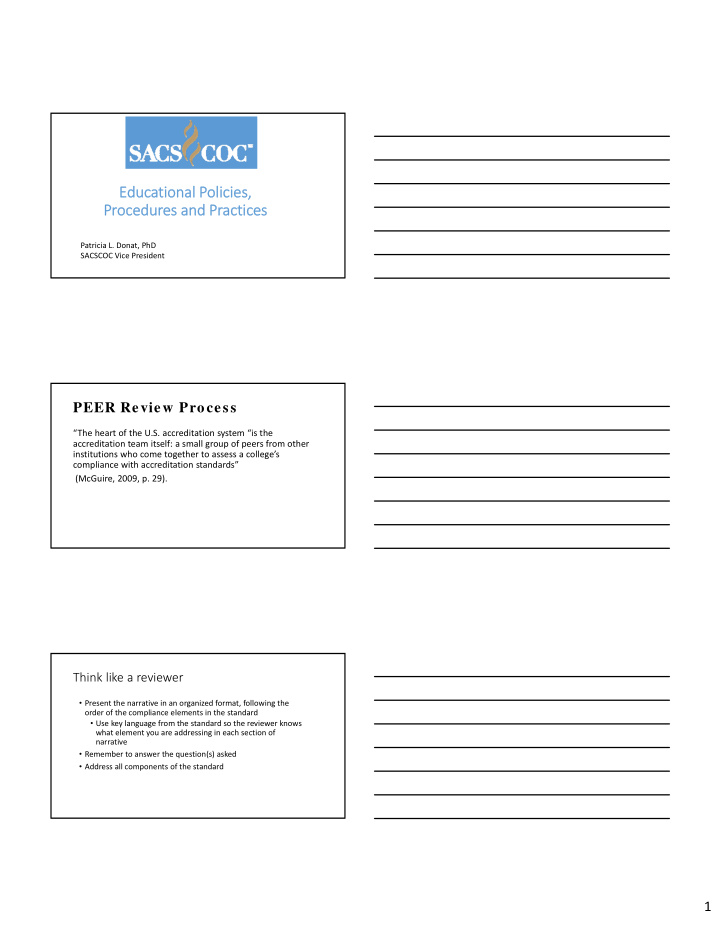



Educ ucational nal Polic licie ies, Procedur ocedures es and and Pr Practices Patricia L. Donat, PhD SACSCOC Vice President PEER Review Process “The heart of the U.S. accreditation system “is the accreditation team itself: a small group of peers from other institutions who come together to assess a college’s compliance with accreditation standards” (McGuire, 2009, p. 29). Think like a reviewer • Present the narrative in an organized format, following the order of the compliance elements in the standard • Use key language from the standard so the reviewer knows what element you are addressing in each section of narrative • Remember to answer the question(s) asked • Address all components of the standard 1
Think like a reviewer • Use your narrative to make your case for compliance • Support your case for compliance with two types of evidence • Documents that describe how the institution operates: Bylaws, strategic plan, catalog, handbooks, manuals, policies, procedures, etc. • Documents that show how the institution operates in practice: Minutes, completed inventories, completed evaluations, completed audits, completed course approval forms, completed degree audits, copies of student complaints, assessment rubric results, survey results, redacted transcripts, etc. Section 10: Educational policies, procedures, and practices • Effective academic policies are: • Developed in concert with appropriate input and participation of constituencies affected by policies (documentation of approval/approval process ) • Conform to commonly accepted practices in higher education • Accurately portray the institution’s programs and services • Are disseminated to those benefiting from such practices. • Remember to include documentation of implementation or enforcement of policies (or include a statement attesting to the fact that a policy has never been implemented) for those standards requiring it • There are no core requirements in this section. 10.1: Academic policies • Editorial changes are not intended to be substantive in nature (previously 3.4.5). • Please note the section, “The Requirement of a Policy” at the front of the Resource Manual . Policies under this standard should be: • Published • Implemented • Disseminated • Reflect good educational practice • Accurately represent the institution and its programs/services 2
10.2: Public information • Note that “cost of attendance” was added as a component of this standard (previously 4.3). • This standard expects that the institution provides constituents with current information about: • Academic calendar • Grading policies • Cost of attendance • Refund policies 10.3: Archived information • Given students’ patterns of attendance and movement between institutions, access to archived catalogs is essential. Institutions need to provide documentation that students have access to these archived documents, regardless of their format (digital/print). 10.4: Academic governance • Editorial changes are not intended to be substantive in nature, even though this standard is a combination of three previous standards (3.4.1, 3.4.10, 3.7.5) Be certain to address all parts of the standard: • • Policies regarding the faculty role in academic and governance matters • Involvement in governance (i.e.,, standing committees, strategic planning, ad hoc committees, Faculty Senate) • Approval process for educational programs (which it is assumed will include faculty and administrative approvals) • Responsibility of faculty for content, quality, and effectiveness of curriculum 3
10.5: Admissions policies and practices • Editorial changes are not intended to be substantive in nature, even though this standard is a combination of three previous standards (3.4.3, 3.13.7, 4.6). • Be certain to address all parts of the standard: • Publication of policies that are consistent with mission • Recruitment materials and presentations accurately represent the institution • Documentation that independent contractors or agents also follow the same principles and policies 10.6: Distance and correspondence education • Editorial changes are not intended to be substantive in nature, even though this standard is a combination of three previous standards (4.8.1, 4.8.2, 4.8.3) • Be certain to address all parts of this standard: • Verification of student identity • Protections for student privacy (Note: Mentioning FERPA alone is not sufficient as it applies to all students.) • Notification of additional charges associated with verification of student identity 10.7: Policies for awarding credit • This standard combines three previous standards (3.4.6, 3.4.8, 4.9) and • clarifies the applicability of the standard to traditional, online, and direct assessment programs and • the importance of the role of individuals who are academically qualified to make decisions about the amount and level of credit awarded. • Remember to include the policy and then describe and document the process for determining both the amount and the level of credit. • This standard addresses the awarding of credit for courses originating with the institution . 4
10.8: Evaluating and awarding academic credit • This standard addresses the awarding of credit for courses not originating with the institution (i.e., transfer, experiential learning, credit by examination, Advanced Placement, etc.). • Be certain to address all parts of the standard: • Policies and procedures for ensuring academic quality • Oversight by academic qualified individuals in the approval process (addition to previous 3.4.4) • Equivalency of credit to credit originating at the institution 10.9: Cooperative academic arrangements • This standard addresses the awarding of credit for courses not originating with the institution and offered through a cooperative academic arrangement, but transcripted as the institution’s own credit (previously 3.4.7, 3.13.2). • Be certain to review both domestic and international cooperative academic arrangements where instruction that is not provided by the institution (and its own faculty), but is transcripted as institutional credit. • The agreement and institutional practices should have robust mechanisms to ensure the quality and the integrity of the academic work recorded on the transcript. Questions? Note: The resource manual is published on the SACSCOC website. 5
Recommend
More recommend